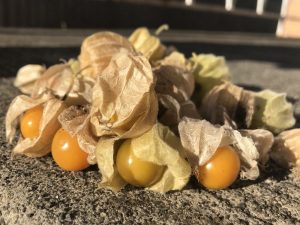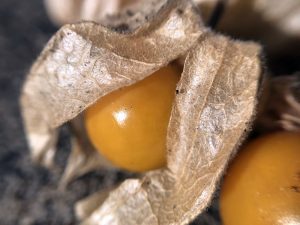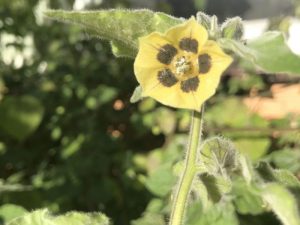Why you should choose a cape gooseberry plant for your garden
Megan Cassidy, from Greensborough, is active within Sustainable Greensborough.
 My problem
My problem
My daughter’s bedroom faces west and, as our house is a brick veneer, this is a problem in summer. The bricks absorb the heat and radiate it into her room all night, making it rather uncomfortable for her. I decided that, rather than cool her bedroom internally, I would stop the bricks heating up in the first place by planting something against the external wall.
The (yummy) solution
Enter, the cape gooseberry (Physalis peruviana). It is in the Solanaceae or nightshade family, which is the same as tomatoes and the tamarillo. The fruit has lots of tiny edible seeds, and it tastes a little like a tiny, tangy, zingy tomato. It has to be tried several times to fully appreciate its flavour though, as it’s a very distinctive and different  taste.
taste.
How it grows
The growth habit of the cape gooseberry bush is of multiple stalks coming from its central root. It grows readily in warm and sunny conditions, and has attractive little yellow flowers with a dark brown pattern around the centre. It should be noted that, as it grows quite easily, it can get a bit out of control under warmer conditions, so ask your local grower/nursery if that’s something you need to consider.
Our plant has spread out across the bricks to be approximately 2m wide and, at its peak height last year, about 2m high. The leaves are medium sized, a bit hairy and soft, but also tough. Throughout last summer, they did not suffer greatly from wilt or burn.
 Once established, the cape gooseberry can provide many hundreds of small yellow round edible berries, of about 1-2cm across. The berries are encased in a papery husk that starts out green and flexible, and turns into a cool-looking ‘skeleton cage’ with the yellow berry peeping through, so that you know it is ready.
Once established, the cape gooseberry can provide many hundreds of small yellow round edible berries, of about 1-2cm across. The berries are encased in a papery husk that starts out green and flexible, and turns into a cool-looking ‘skeleton cage’ with the yellow berry peeping through, so that you know it is ready.
Water needs are fairly low-moderate. It’s hard to know exactly because we put it near a downpipe which goes straight onto the garden.
Harvesting yield and uses
From October 2020 to March 2021, I picked 1.25kg, which was over  500 berries! This year (2021), the flowering started in late winter, and has already provided us with about 100 berries, with hundreds more ripening up.
500 berries! This year (2021), the flowering started in late winter, and has already provided us with about 100 berries, with hundreds more ripening up.
So, what to do with them all? They are great for eating straight off the bush – they often don’t even make it past the little helpers who gather them! I do prefer to give them a wash first, to get the waxy, slightly sticky sheen off it, but this is not essential.
They go well in salads in place of cherry tomatoes, in salsas and baked tomato dishes. You can jam them easily because they are high in pectin. Don’t eat the green ones though! If you have a dehydrator, you can even make your own inca berries – yes, those expensive
superfoods you see at the health food shops for $50/kg!
 Health benefits listed are impressive. The berries are apparently a good source of vitamins A and C, and also contain calcium, riboflavin, iron, phosphorus and potassium. Anti-inflammatory properties have also been attributed to this tiny fruit and it has been used in traditional medicine for a long time.
Health benefits listed are impressive. The berries are apparently a good source of vitamins A and C, and also contain calcium, riboflavin, iron, phosphorus and potassium. Anti-inflammatory properties have also been attributed to this tiny fruit and it has been used in traditional medicine for a long time.
Why plant a cape gooseberry?
Because the benefits of this plant are many!
- Shade to lower your air-conditioning needs if placed in a strategic westerly-facing direction.
- A hardy, attractive bush that provides habitat and forage for insects in your garden, as well as pleasant views for you.
- Plentiful, versatile fruit which can be eaten fresh or preserved.
- A tomato substitute for the colder months before tomato season kicks in.
- Health benefits.
A final personal thought
My daughter’s room has been cooler since we put this plant in and I enjoy looking out her window and spotting the brown papery pods I can go out and pick. It’s a reminder to get out in the garden and enjoy the fruits of my labour!

Delicious as a jam, or as a dessert tart. And they are tart! Sweeten to taste, but I find the acid delightful. I have never had it in a savoury dish but next time I have some I will try them in a salad as suggested.
I planted a few plants – and most of them have died down – one is putting on new growth. I live in Melbourne and it has been very cold. Should I pull out the plants that have died off or will they re shoot?
Thank you
Hi Tania,
My experience is that cape gooseberries quite often re-shoot so I would leave them for the time being.
I live in Brisbane, and a couple of cape gooseberries have come up in my garden. As a young country kid I loved them, but here in the suburbs they are being turned almost leafless and fruitless by a small yellow with black stripes beetle. I twice daily collect & squash the beetles, but with little success. I am now trying spraying with White Oil. Does anyone have a better option?
Hi Lorna,
I’m in Northern NSW and have had the same problem 2 seasons in a row. It’s very frustrating.
The beetle, I’ve discovered, is the 3 striped potato beetle and any effort you make is virtually useless as they will win in the end.
I spoke to a knowledgeable gardener recently and he suggested netting them with fine insect netting. My plan is to put all my seedlings in one bed when I’ve gotten them a bit stronger in smaller pots and net them. I just love cape gooseberries so worth another go.
Jo
Hy Megan, do u know or do u have a twig (cape gooseberry)with roots I can buy off you ?? I live in Sunshine, Victoria.
What is the proper species name? I know it starts with P.
Physalis peruviana.
I wasn’t aware this plant was similar to a tomato, that is very helpful, thank you. Just wondering how high your summer temps are? We have a West facing wall but are talking some weeks of mid-30s and over 40, our spring is quite cool. We are also still getting lots of rain, so I’m thinking a large pot to help with drainage. Your thoughts?
Would possums eat the foliage? I have exactly the same problem of a west facing bedroom and have tried vines which the possums have eaten through.
Possums don’t seem to eat them, nothing does in my garden. We had them in Zimbabwe when I was growing up and I love them. They like sun to ripen the fruit, it’s a bit too cool in my Gippsland garden so fruit is late, but plentiful.